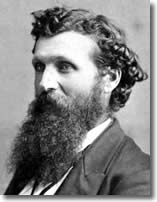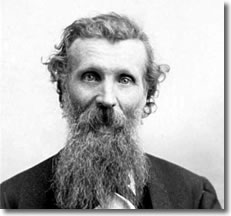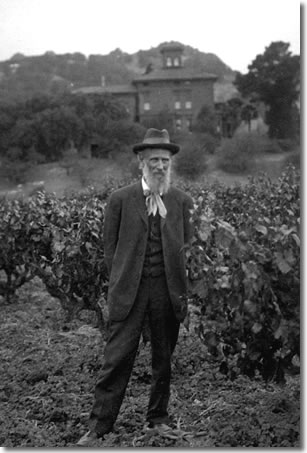John Muir (1838-1914)
A Brief Biography
Courtesy of Ecotopia Ecology Hall of Fame
1868 - An Remarkable Era Begins
 In the spring of 1868, a young man came to Yosemite and changed the world. Muir had just turned 30 that year. His first 11 years were spent in Dunbar, Scotland. The next 11 he spent in the backwoods of Wisconsin, working through the daylight hours, clearing the forest, holding a plow to a straight furrow behind a team of oxen, digging wells through hard bedrock, and taking an adult's part in subduing wild nature.
In the spring of 1868, a young man came to Yosemite and changed the world. Muir had just turned 30 that year. His first 11 years were spent in Dunbar, Scotland. The next 11 he spent in the backwoods of Wisconsin, working through the daylight hours, clearing the forest, holding a plow to a straight furrow behind a team of oxen, digging wells through hard bedrock, and taking an adult's part in subduing wild nature.
Years later, in The Story of My Boyhood and Youth, he stressed the rigours of his childhood, but he seemed to feel that his strenuous years in Wisconsin prepared him well for his later wilderness ramblings.
He also prepared throughout his childhood for his life as a naturalist by a close attention to the wonders of nature. Everything, it seemed, drew his eye and his mind, and all creatures drew his sympathy, whether the mice that ate the grain he had wrung from the earth by the sweat of his brow or the intelligent old ox Buck, who figured out how to open pumpkins to feast on the succulent inner flesh.
As a teenager, he had no time for school and little opportunity for formal study. Yet his mind hungered for knowledge. When his father grudgingly gave permission for him to rise before the rest of the family to read, he took to rising at one in the morning. He wrote, "I had gained five hours, almost half a day! 'Five hours to myself!' I said. 'Five huge, solid hours!' I can hardly think of any other event of my life, any discovery I ever made that gave birth to joy so transportingly glorious as the possession of these five frosty hours."
Much of this new-won time he gave over to his inventions. In fact, it seems he was an inventor of substantial gifts. He created a thermometer so sensitive that it would react to the heat radiated by the body of a person standing four or five feet away. Another creation was an alarm clock that, at the appointed time, tipped up his bed and dumped him on the floor. He called it an "early-rising machine."
A Short Formal Education
 These machines and his desire to escape from his overbearing father took him to Madison, Wisconsin and brought him to the attention of several people from the University of Wisconsin. He was admitted, though he had spent only a few months in school after the age of 11. In the following two and a half years, he followed an electic course of study, heavy on Natural Science, and left in 1863.
These machines and his desire to escape from his overbearing father took him to Madison, Wisconsin and brought him to the attention of several people from the University of Wisconsin. He was admitted, though he had spent only a few months in school after the age of 11. In the following two and a half years, he followed an electic course of study, heavy on Natural Science, and left in 1863.
Over the next three years he worked as a mechanic and took several short wilderness trips. Much of the Civil War he spent in Canada, perhaps to avoid the draft, though that is far from certain. What is certain is that in 1867 a momentous accident changed his life. He was adjusting some machinery with a file when his hand slipped. A point of the file pierced one eye. He lost the use of that eye. The other soon went dark in sympathy. It was the darkest moment of his life for his spirit, as well as his sight.
As his sight gradually returned, over a period of months, he felt that he had been re-born. He resolved to spend the rest of his life immersed in the sights that had been denied him in his darkened sickroom—the forests, fields, lakes and mountains of pure, unspoiled nature.
His first great wilderness adventure was a thousand mile walk from Louisville, Kentucky to Savannah, Georgia. From there, he hoped to travel to the headwaters of the Amazon and work his way to the sea. But a case of malaria laid him low in Florida and, by a wandering course, he ended up in San Francisco in March, 1868. He inquired the nearest way out of town. "'But where do you want to go?' asked the man to whom I had applied for this important information. 'To any place that is wild,' I said."
So he went to Yosemite
 The next six years brought about another transformation. His first summer in Yosemite, he worked as a shepherd. Then he ran a sawmill near the base of Yosemite Falls. But all the time he was working, he was studying nature, the great truths that, he said, were written in "magnificent capitals"—the awesome stones of the Sierra Nevada. He became a guide for some of the most famous of Yosemite's visitors, including one of his idols, Ralph Waldo Emerson.
The next six years brought about another transformation. His first summer in Yosemite, he worked as a shepherd. Then he ran a sawmill near the base of Yosemite Falls. But all the time he was working, he was studying nature, the great truths that, he said, were written in "magnificent capitals"—the awesome stones of the Sierra Nevada. He became a guide for some of the most famous of Yosemite's visitors, including one of his idols, Ralph Waldo Emerson.
Emerson tried to entice Muir away from Yosemite, telling him the world was waiting to hear him teach the lessons he had learned. But Muir chose to follow the ideal Emerson had set forth in "The American Scholar." He stayed in his mountains, working, studying and learning.
Eventually, he did leave the Valley. First for only a few months at a time. He would live with friends in San Francisco or Oakland and write about his glorious mountains, the scenery that drew tourists and the science behind the scenery. Gradually, he spent more time in the Bay Area and less time in Yosemite. In 1880, he married and moved to Martinez, California, 35 miles from San Francisco.
He still traveled, sometimes to Yosemite, several times to Alaska. But the decade of the 1880's saw him mostly in Martinez, applying his love of plants and fecund imagination to the task of raising Bartlett pears and Tokay grapes. He became fairly wealthy, but seemingly discontented. Each trip to the mountains presented him with more proof that, unless something were done, the glorious wilderness he had found in 1868 would soon be only a memory.
Tuolumne Meadows Trip Was a Catalyst
Muir's budding re-awakening to literary and political activity was brought to fruition by Robert Underwood Johnson, editor of Century, one of the most prominent magazines in the country a hundred years ago. The catalyst was their famous camping trip to Tuolumne Meadows in 1889. Each seemed to have thought the trip was a way to inspire the other to do something to save the High Sierra from the sheep which Muir felt were rapidly altering the sub-alpine environment. Muir wrote two long articles on Yosemite, advocating a National Park to surround what was then the state-run Yosemite Valley. Johnson published the articles and lobbied energetically. Congress complied with this emotional and literary onslaught, creating a National Park that included almost all the present-day park plus the southeastern area down to Devils Postpile that was excised in 1905 when the Valley was taken from state control and added to the National Park.
1892, the Sierra Club is Created
Another fruit of this budding friendship was the creation, in 1892, of the Sierra Club, with Muir as President, apostle, guide, and inspiration. The purpose of the Club was to preserve and make accessible the Sierra Nevada.
The Club grew slowly and quietly for a few years, then a little faster after 1901 with the start of the High Trips. But not until the City of San Francisco began its push for a dam on the Tuolumne at the mouth of Hetch Hetchy Valley was the whole idea of preservation vs. use articulated on the front and editorial pages of the nation's newspapers.
Muir summed up the basic arguments against the dam in some of his most elegant, most elevated prose:
"These temple destroyers, devotees of ravaging commercialism, seem to have a perfect contempt for Nature, and, instead of lifting their eyes to the God of the mountains, lift them to the Almighty Dollar.
"Dam Hetch Hetchy! As well dam for water-tanks the people's cathedrals and churches, for no holier temple has ever been consecrated by the heart of man."
Climb the Mountains
 The Sierra Club, and the environmental movement as a whole, have grown most rapidly in times of severe, well-publicized threats to the environment. But over the years, slow and steady growth can be traced directly to those who have followed Muir's advice, "Climb the mountains and get their good tidings." In 1900, Sierra Club Secretary Will Colby envisaged a mass outing for the Sierra Club, to introduce as many people as possible to the wonders of the mountains. The following summer, 1901, ninety-seven "Sierrans" including Muir and his two daughters assembled in The Valley and trekked to Soda Springs for a month of hiking, peak climbing, campfire entertainment and education. One woman wrote of the trip:
The Sierra Club, and the environmental movement as a whole, have grown most rapidly in times of severe, well-publicized threats to the environment. But over the years, slow and steady growth can be traced directly to those who have followed Muir's advice, "Climb the mountains and get their good tidings." In 1900, Sierra Club Secretary Will Colby envisaged a mass outing for the Sierra Club, to introduce as many people as possible to the wonders of the mountains. The following summer, 1901, ninety-seven "Sierrans" including Muir and his two daughters assembled in The Valley and trekked to Soda Springs for a month of hiking, peak climbing, campfire entertainment and education. One woman wrote of the trip:
"Muir, the prince of mountainlovers, was guide and apostle, and his gentle, kindly face, genial blue eyes, and quaint, quiet observations on present and past Sierra conditions impressed us unforgettably with the 'sermons in stone, books in the running brooks,' he knows so well."
These outings became an annual affair, and evolved into the Club's current schedule of dozens of trips all over the world. Periodically, the Board of Directors reminds the membership that the outings were not the reason the Club was started. Will Colby himself wrote, in the January 1904 Bulletin, that membership was up to nearly 800, "mainly due to the annual Club Outing. ... Our members should not, however, lose sight of the fact that this feature of the Club's life is but a minor part ... of the worthy objects for which the Club was incorporated ... the preservation of the forests and the natural scenery of our mountains."
Marion Parsons, one of the few women leaders of the early Sierra Club, answered Colby in her own article in the 1904 Bulletin: "The Sierra Club has great and noble purposes, for which we honor it, but besides these its name has come to mean an ideal for us. It means comradeship and chivalry, simplicity and joyousness, and the carefree life of the open."
John Muir's Ecstasy
Thirty years later, twenty years after Muir's death, another woman wrote of her own experiences on a High Trip. "Never had I really understood John Muir's ecstasy until I wandered through this little valley." That "ecstasy" was exactly what Muir found most lacking in California, even among his fellow "preservationists." "The love of Nature among Californians is desperately moderate; consuming enthusiasm is almost wholly unknown." It was this ecstasy in Nature that distinguished Muir from most other preservationists and it was this very emotionalism that made him so attractive to the women he met as well as others who weren't embarrassed by their emotional response to Nature.
Over the years, Muir developed from a guide for select individuals to a guide for the Sierra Club to a guide for the whole nation. Not just to Yosemite or any other specific place, but to the inner regions of the emotional response to Nature, especially Wild Nature.
John Muir, 1838-1914
 Muir died of pneumonia in a Los Angeles hospital in January, 1914. It was a unexpectedly prosaic end for a man who had repeatedly faced death on rocky crags and icy glaciers, who braved Alaskan storms with a crust of bread in his pocket. In the years since, his legend has grown. In 1976, the Calfiornia Historical Society voted him "The Greatest Californian." The U.S. Geological Survey has suggested an even greater mark of his fame. In their guidelines on naming mountains and lakes after individuals, it gives Muir as the example of someone who has had so many things named for him already that they would not be likely to approve any further such commemorations.
Muir died of pneumonia in a Los Angeles hospital in January, 1914. It was a unexpectedly prosaic end for a man who had repeatedly faced death on rocky crags and icy glaciers, who braved Alaskan storms with a crust of bread in his pocket. In the years since, his legend has grown. In 1976, the Calfiornia Historical Society voted him "The Greatest Californian." The U.S. Geological Survey has suggested an even greater mark of his fame. In their guidelines on naming mountains and lakes after individuals, it gives Muir as the example of someone who has had so many things named for him already that they would not be likely to approve any further such commemorations.
But perhaps the greatest tribute ever given to Muir took place in a private conversion between two great contemporary mountaineers. Galen Rowell once asked Rheinhold Messner why the greatest mountains and valleys of the Alps are so highly developed, why they have hotels, funicular railways, and veritable cities washing up against sites that, in America, are maintained relatively unencumbered by development. Messner explained the difference in three words. He said, "You had Muir."
